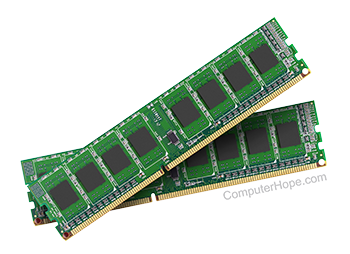RAM

Alternatively called main memory, primary memory, or system memory, RAM (random-access memory) is a hardware device that allows information to be stored and retrieved on a computer. RAM is usually associated with DRAM (dynamic random-access memory), a type of memory module. Because data is accessed randomly instead of sequentially like it is on a CD (compact disc) or hard drive, access times are much faster. However, unlike ROM (read-only memory), RAM is a volatile memory and requires power to keep the data accessible. If the computer is turned off, all data contained in RAM is lost.
New users often confuse RAM with disk drive space. See our memory definition for a comparison between the two.
Types of RAM
Over the evolution of the computer, there have been different variations of RAM. Examples are DIMM (dual in-line memory module), RIMM, SIMM (single inline memory module), SO-DIMM (small outline dual in-line memory module), and SOO-RIMM. Below is an example image of a 512 MB DIMM computer memory module, a piece of RAM found in older desktop computers. This memory module would be installed into one of the memory slots on a motherboard.

Additional RAM information
As the computer boots, parts of the operating system and drivers are loaded into memory, which allows the CPU (central processing unit) to process instructions faster and speed up the boot process. After the operating system is loaded, programs you open like the browser you're using to view this page are also loaded into memory. If too many programs are open, the computer swaps the data in the memory between the RAM and the hard disk drive.
A computer's performance is largely attributed to the amount of memory it contains. If a computer does not have the recommended memory to run the operating system and its programs, it results in slower performance. The more memory a computer has, the more information and software it can load and process quicker.
What's the largest stick of RAM?
Currently, the largest single stick of RAM is 128 GB.
History of RAM
The first form of RAM came about in 1947 with the Williams tube. It utilized a CRT (cathode ray tube); the data was stored on the face as electrically charged spots.
The second widely used form of RAM was magnetic-core memory, invented in 1947. Frederick Viehe is credited with much of the work, having filed for several patents relating to the design. Magnetic-core memory works through tiny metal rings and wires connecting to each ring. One bit of data could be stored per ring and accessed at any time.
However, RAM, as we know it today, as solid-state memory, was first invented in 1968 by Robert Dennard. Known specifically as dynamic random-access memory, or DRAM, transistors store bits of data.
DDR, DDR2, DDR3, DDR4, Dynamic storage, Hardware terms, Memory, Memory terms, Optane memory, Primary storage, RDRAM, SDRAM, SIMM, Storage
